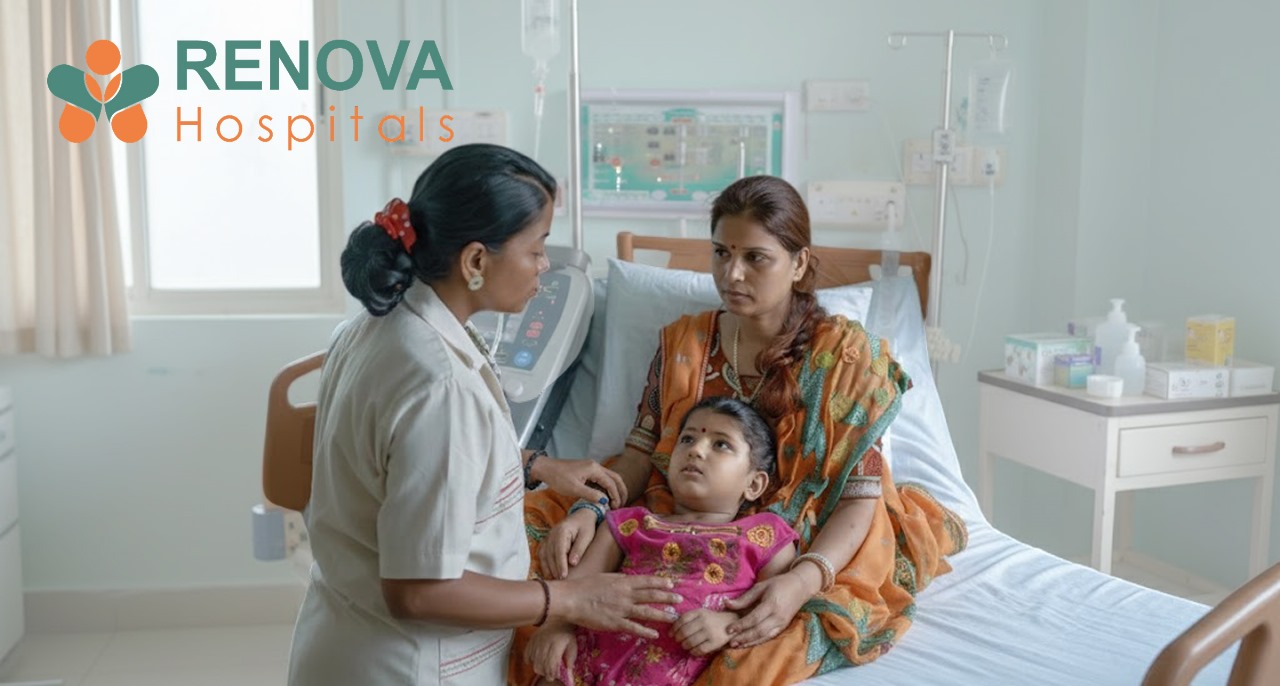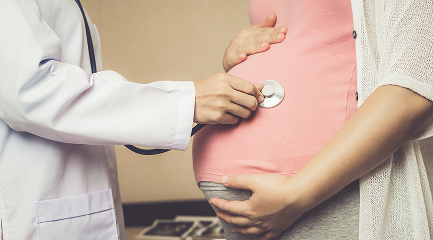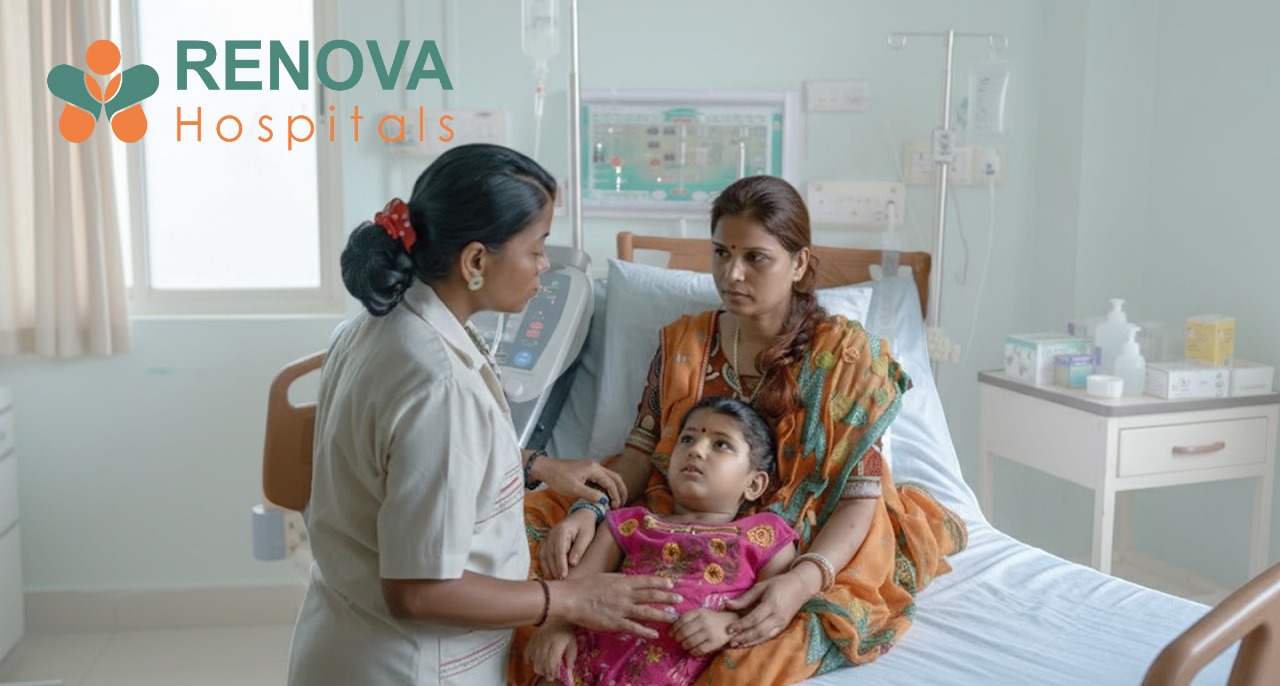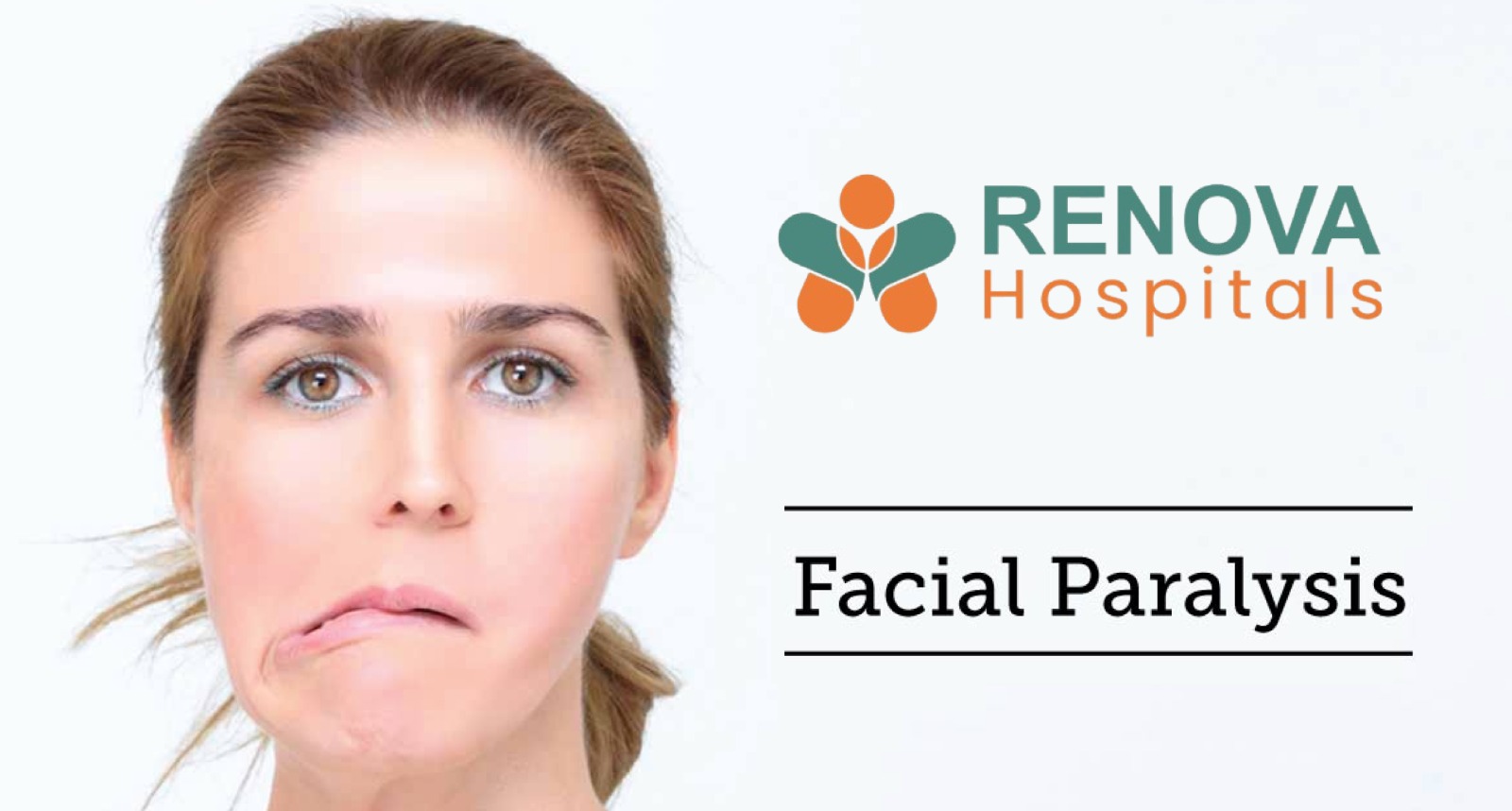
By Renova Hospitals
November 21, 2025
Eclampsia: Causes, Symptoms, Stages & Emergency Treatment at Renova Hospitals Hyderabad
Understanding what is eclampsia, recognising early warning signs, knowing the stages of eclampsia, and ensuring immediate hospital care are essential to protect both mother and baby.
What Is Eclampsia?
Eclampsia occurs when preeclampsia, a dangerous condition involving high blood pressure, protein leakage, swelling, and organ strain, progresses to seizures. These seizures happen because the brain becomes overwhelmed by swelling, vessel dysfunction, and sudden severe hypertension.
Preeclampsia progresses to imminent eclampsia → culminating in seizures (eclampsia).
How Eclampsia Develops: Pathophysiology Explained
Before listing them, it’s essential to understand that the root cause begins in the placenta, not the brain.
- Abnormal placental blood vessels restrict blood flow
- The placenta becomes stressed and releases toxic inflammatory proteins
- These proteins damage the inner lining of blood vessels
- Blood vessels throughout the body become constricted and leaky
- Blood pressure increases dramatically
- The brain becomes swollen and irritated
- Electrical activity becomes unstable
- A seizure occurs
This cascade shows why treating blood pressure early in pregnancy is crucial to prevent eclampsia.
Eclampsia Causes
Major Eclampsia Causes Include:
- Severe preeclampsia progression
- Abnormal placental development
- Poor blood flow to the placenta
- Maternal immune response problems
- Genetic predisposition
- Inflammatory damage to blood vessels
- Uncontrolled high blood pressure
These eclampsia causes interact silently during pregnancy, which is why antenatal checkups are essential.
Risk Factors of Eclampsia
- First-time pregnancies
- Multiple pregnancy (twins, triplets)
- History of hypertension
- Kidney disease
- Diabetes
- Autoimmune disorders
- Teen pregnancies
- Advanced maternal age
- Obesity
- Family history of preeclampsia
- Limited or irregular prenatal care
Stages of Eclampsia
1. Preeclampsia
- Elevated blood pressure
- Protein in urine
- Swelling
- Mild headaches or discomfort
- Very high blood pressure
- Intense headaches
- Visual disturbances
- Liver pain
- Fluid retention
- Breathlessness
- Excruciating headache
- Confusion or restlessness
- Very brisk reflexes
- Severe vision disturbances
- Intense upper abdominal pain
- Persistent nausea
- Facial swelling
- Feeling “unwell” or “not right”
Recognising imminent or impending eclampsia can prevent seizures entirely if treated in time.
4. Eclamptic Seizure
- Confusion
- Deep sleep
- Temporary breathing issues
- Risk of repeat seizures
Warning Signs of Eclampsia
- Persistent headache
- Light sensitivity
- Flashing lights or blurred vision
- Facial or hand swelling
- Sudden weight changes
- Shortness of breath
- Sharp abdominal pain under ribs
- Nausea and vomiting
- Reduced fetal movements
Signs of Eclampsia During a Seizure
- Full-body convulsions
- Jerking movements
- Loss of consciousness
- Foaming at the mouth
- Tongue biting
- Temporary breathing pause
- Restlessness after seizure
What is the Difference between Preeclampsia and Eclampsia?
- Preeclampsia → High BP + organ strain
- Eclampsia → Preeclampsia + Seizures
In some cases, it can lead to stroke or death. In most cases, preeclampsia is managed before it progresses to eclampsia. Eclampsia is the final and most dangerous stage of uncontrolled preeclampsia.
Complications of Eclampsia
- Stroke
- Brain swelling
- Heart failure
- Kidney failure
- Liver injury
- Placental abruption
- Vision loss
- Multi-organ failure
- Coma
- Restricted growth
- Oxygen deprivation
- Preterm delivery
- Stillbirth
Understanding the complications of eclampsia highlights why timely treatment is essential.
Eclampsia Diagnosis
- Blood pressure assessment
- Evaluation of consciousness
- Protein in urine
- Liver and kidney function tests
- Platelet counts
- Ultrasound to assess fetal well-being
- Brain imaging if complications are suspected
Nursing Diagnosis for Eclampsia
- Risk for injury related to seizures
- Ineffective airway clearance
- Altered cerebral perfusion
- Risk for aspiration
- Fluid imbalance
- Anxiety and fear
- Risk of impaired fetal perfusion
- Ineffective breathing pattern
Medical Management of Eclampsia
- First, a loading infusion is given intravenously to stop seizure activity.
- This is followed by a continuous maintenance infusion administered at a steady, controlled pace.
- The treatment continues for a fixed period after the last seizure to prevent recurrence.
- Reflexes
- Breathing
- Urine output
- Consciousness
- Improve blood vessel relaxation
- Reduce stroke risk
- Improve blood flow to organs
- Decrease risk of placental abruption
- The patient is positioned on her left side
- Oxygen is provided
- Suction is used if needed
- Breathing is monitored continuously
- Assisted ventilation may be provided if necessary
- Controlled IV fluids
- Continuous maternal vital monitoring
- Round-the-clock fetal monitoring
- Regular organ function tests
- Maternal condition
- Fetal status
- Cervical readiness
Outlook / Prognosis of Eclampsia
- Attend all prenatal appointments
- Monitor blood pressure at home
- Report any headaches, swelling, or vision changes
- Take prescribed medications regularly
- Follow postpartum monitoring instructions
Renova Hospitals Hyderabad: Expert Care for Eclampsia Patients
Renova Hospitals offers emergency care for severe hypertension in pregnancy, preeclampsia & eclampsia, HELLP syndrome and postpartum hypertensive crises.
















